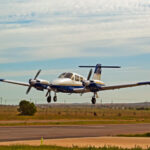I made the unfortunate mistake of landing on a closed runway in the middle of the night many years ago and it still haunts me to this day. Yes, I checked my flight plan and notams and the weather, but somehow I missed the very important runway closure.
To my credit, sort of, the runway was still open to military operations, so it wasn’t like there was a big giant X on each end, but still, I messed up. ForeFlight 12.1 is the latest update intended to help pilots make better informed decisions and actually avoid making big, stupid blunders like I did.
12.1 has 3 new features designed to help both on the ground and in the air. It helps with route planning prior to the flight and it also reduces the pilot workload when looking at datalink weather in the air. They say that if you look at the app at least once before your flight it would be impossible to miss an airport or runway closure. I like the sound of that!
A large red banner appears on the airport screen when there is a closure, along with a red banner on the pop up airport window on the map. That does sound pilot proof, doesn’t it?? A red badge will also appear on the airport ID bubble in the route editor, indicating a closure of some type.
In the latest update, they have extended this closure warning to the Procedure Advisor Screen. When viewing the list of runways, ForeFlight adds a “See NOTAM” or “Runway Closed” tag to any runway that is closed or even partially closed by NOTAM. Yup, idiot proof.
The next app improvement is in the Route Advisor feature. The original feature was designed to take the guesswork out of selecting your route by displaying recommended routes and recently cleared ATC routes. The latest update adds the option of adding additional constraints to your route of flight.
There are three new options on the route constraint settings. To access this page, press the Route Advisor button on the Route Editor Screen, then tap the button on the top right hand corner. You will see 3 new options here:
- Include waypoints – simply type in one or more navaids, waypoints or airports separated by commas or spaces to ensure these are included in the route suggestions
- Avoid waypoints – type in one or more navaids, waypoints or airports separated by commas or spaces to ensure these are NOT included in the route suggestions
- Avoid FIR (flight information regions) – select airspace sectors and regions you would like to avoid overflying, especially important when flying internationally, to help avoid dangerous or costly airspace.
Finally, there is now a weather- layer “auto” altitude select. This is important when flying with an ADS-B or XM receiver, since several of the weather layers are altitude based (winds aloft, icing, turbulence or ADS-B cloud tops). When viewing in-flight data link weather, the auto button will automatically select the closest altitude to your GPS-based altitude. This will make sure you are always viewing the most relevant information without having to manually select an altitude throughout your flight.
These new updates exist to help pilots create a flight plan that will be both efficient and safe. The more you use this new technology, the easier your planning will be and the chances of making a stupid mistake will virtually disappear!!
RELATED READING
RELATED CTS TRAINING









